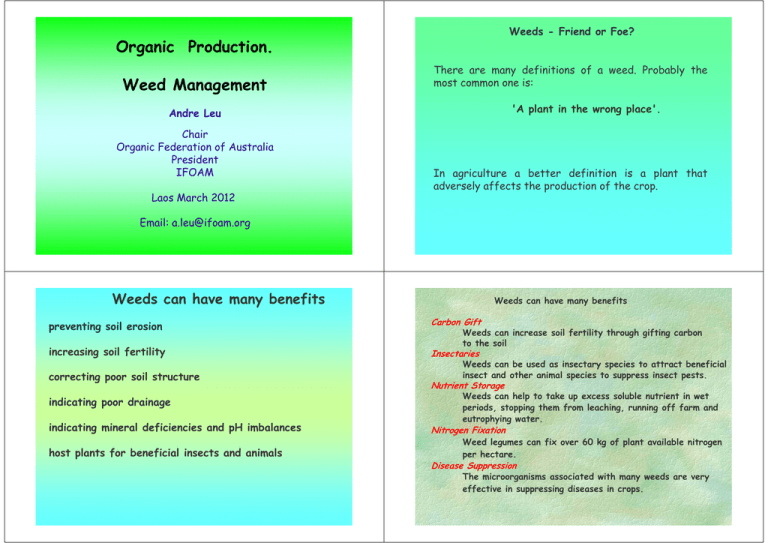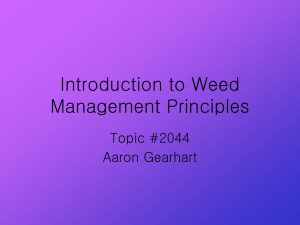Organic Production Organic Production. Weed Management
advertisement

Weeds - Friend or Foe? Organic Production. Production Weed Management There are many y definitions of a weed. Probably y the most common one is: 'A plant l t in i the th wrong place'. l ' Andre Leu Chair Organic Federation of Australia President IFOAM L Laos March M h 2012 In agriculture a better definition is a plant that adversely affects the production of the crop. Email: a a.leu@ifoam.org leu@ifoam org Weeds can have many benefits Weeds can have many benefits preventing soil erosion Carbon Gift increasing soill fertility f l Insectaries correcting poor soil structure indicating g poor p drainage g indicating mineral deficiencies and pH imbalances host plants for beneficial insects and animals Weeds can increase soil fertility through gifting carbon to the soil Weeds can be used as insectary species to attract beneficial insect and other animal species to suppress insect pests. pests Nutrient Storage Weeds can help to take up excess soluble nutrient in wet periods stopping them from leaching periods, leaching, running off farm and eutrophying water. Nitrogen Fixation Weed legumes can fix over 60 kg of plant available nitrogen per hectare. Disease Suppression The microorganisms associated with many weeds are very effective in suppressing diseases in crops. The Carbon Gift The Carbon Gift Between 95 and 98% of plant minerals come from water, carbon dioxide and d oxygen. The remaining g 5% come from f the soil. 30-60% of the carbon and energy used by plants is deposited into the soil Plant roots put thousand of tonnes per hectare of organic carbon and bio available minerals into the soil every year. These carbon based molecules feed billions of microbes – actinomycetes, bacteria and fungi that are beneficial to plants Plants roots are an important part of the process of forming top soils and good soil structure. This means that plants can put more nutrients into the soil than they remove from it. If the weeds are managed properly, and their residues are allowed to return to the soil, their nutrient removal from the soil is zero. MANAGING GROUND COVERS MANAGING GROUND COVERS Cut plants add organic carbon into the soil to feed the microorganisms and the crop Biological activity in soil is stimulated by y rootmass activity which feeds microbe communities and generates soil carbon and nutrients for the crop MANAGING GROUND COVERS MANAGING GROUND COVERS Weed Management Strategies Essentially weeds cause problems by 1 1: Competing for f Sunlight l h 2: Competing for Soil Nutrients 3: Competing p g for Soil Water 4: Host for pests and diseases and contamination of crop with i h weed d residues. id 1: Competing for Sunlight Sunlight is the most important of all negative attributes of weeds. Photosynthesis is the basis of most crops. Weeds d that h reduce d the h amount of f solar l energy collected during photosynthesis will reduce the yield of the crop. crop It is important that all weed management strategies ensure that the weeds are kept below the leaves of f the crop. p 2: Competing for Soil Nutrients Good soil nutrition is essential to ensure that weeds do not take up nutrients and leave the crop deficient. 1: Ensure luxury levels of soil nutrients that will supply enough for both the crop and the weeds. 2: Return the weed nutrients to the soil through slashing, grazing, tilling etc. These strategies ensure the weeds are always returning the nutrients that they use. use The Carbon Gift means that they are returning more nutrients and feeding g the crop. p MANAGING GROUND COVERS The roots of the cut plant have b been shed h d and do not compete for water of nutrients MANAGING GROUND COVERS 3 Competing 3: C ti f for Soil S il W Water. t It is important that adequate water is provided for both the weeds and the crop. When water is limited it is important to eliminate or reduce the weeds. Slashing and using the residue for mulch to retain soil moisture is gy the best strategy. Grazing or very shallow tillage before sowing the crop can reduce weed d iinduced d d water lloss. Weeds can be used as to store water and nutrients as mulches. mulches MANAGING GROUND COVERS The roots of the cut plant have been shed and do not compete f water for t of nutrients MANAGING GROUND COVERS 4: Host for pests and diseases and contamination of crop with weed residues. residues These are the weed species that should be concentrated on to be eradicated and/or replaced with beneficial species. Weeds that can contaminate crops with seeds or extraneous matter can eliminated, kept small or prevented from seeding. Cover Crops for Weed Control Methods for controlling weeds Timing g Timing is critical to efficiently control weeds. • “One year’s seeding is seven years weeding” • Weeds are easier to control as they emerge Cover crops Cover crops suppress weeds C d b by out-competing t ti th them Mulching g Mulching is a very effective way of suppressing weeds. Mulch as Weed Control Mulch from the Grass Suppresses W d Weeds Shade as Weed Control Methods for controlling weeds Shade as weed control. control High density planting of crops will control many weeds by shading them out. Competition Beneficial species can out-compete/choke out compete/choke out unwanted weeds Shade and Replacing with Beneficial Species as Weed Control Shade and Replacing with Beneficial Species as Weed Control Full sun systems. systems Phase of establishment with plantains as temporary shade. Agroforestry system with shade leguminous trees, Successional agroforestry system with the same shade trees of the agroforestry treatment and in addition natural regeneration and crops Taking into account natural plant species succession, the high turn over of carbon typical for the conditions of humid tropics, tropics self regulation processes with high biodiversity, to use all storeys and provide as much as possible ecosystem t services i beside b id th the cocoa production. d ti The System’s Approach: Ecointensification High g Yields “Push – Pull” for Stemborer and Striga Control U i Using naturall systems to regulate pest outbreaks ((example p of push-pull greater farm productivity d ti it vs higher yields 2 to 10X) Low growing legumes such as Clover, Alfalfa, Desmodium, P Pinto Peanut P makes k an ideal d l ground d covers They are prostrate, suppresses many weeds, provides nitrogen and the flowers f f function as insectaries f for beneficial f insects Methods for controlling weeds Crop Rotations Crop rotation can be used very successfully to suppress weeds. d Slashing and Mowing Cutting weeds by slashing, cutting and mowing controls weeds. d Methods for controlling weeds Grazing Grazing is one of the most effective methods of weed control Crop p Rotation is very y effective in controlling g weeds by breaking the reproductive cycles Grazing as Weed Control Pasture Cropping Oats Sown into Pasture P t Pasture Cropping C i Methods for controlling g weeds Tillage Tillage is one of the oldest and most effective weed control methods. methods Flame Weeding Fl Flame weeders d are used d tto quickly i kl sear weeds d with ith a naked k d fl flame. Steam Weeding Steam weeding works on the same principles as flame weeding for herbicide use due the ease of use and safety to the environment. Hand Weeding – Pulling, Hoeing and Cutting One of the most effective and efficient methods of weed control Oats Sown into Pasture Quarantine It is important to have systems to stop the introduction of new weeds Insectaries Use a whole of farm approach Research shows that the best organic farmers use multiple integrated strategies for weeds and achieve very good control. It is important to look at weeds from the four criteria. Good organic farmers find that their weed loads significantly reduce over the years. • Refuges of flowering plants are known as insectories • Small flowering plants are encouraged to grow throughout the orchard • Nectar and pollen are essential to the adult stage of many beneficial predators •Research has shown that they breed thousands of beneficial organisms g plant p host more species p than short mowed or bare areas •Tall flowering •Strip mowing used to leave pockets and strips as refuges for beneficials •The remaining are mowed at a later stage leaving other areas as refuges •The rainforest allowed to regenerate in marginal areas on the farm •Watercourses planted to provide habitat for the beneficial bird species •Marginal M i l areas host h t a variety i t of f beneficial b fi i l insect i t species i Weed Control • Slashing/cutting are used to strip mow the rows • Other areas are left untouched until later in the season. • They are necessary as insectaries for beneficial insects. Change the ground cover balance from negatives that compete with crop to p positives • Soil stabilisation, nitrogen fixation, habitat for beneficials, • Mulch and organic matter for trees and soil, • Carbon and nutrient dumping into soil from plant roots. Legumes as a ground cover Legumes, • Adds nitrogen to the soil • Chokes out many of the weed species • Stabilises the soil and builds humus This weed management method produces a lush meadow style rather than a city park look. Eco--intensification Eco Maximises solar capture Th k Thankyou Fixes nitrogen and soil carbon Flowers attract beneficial insects Legume vines in fruit trees




